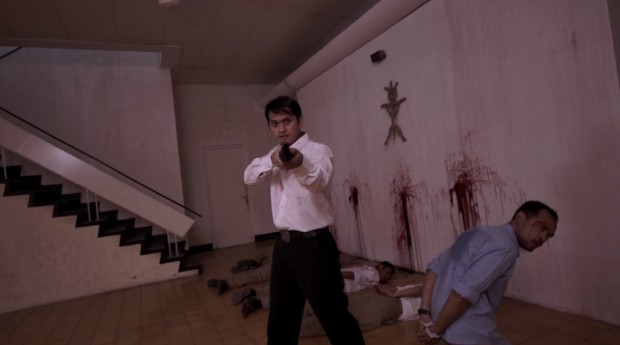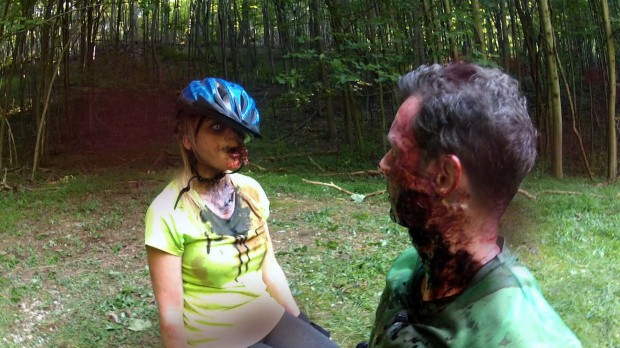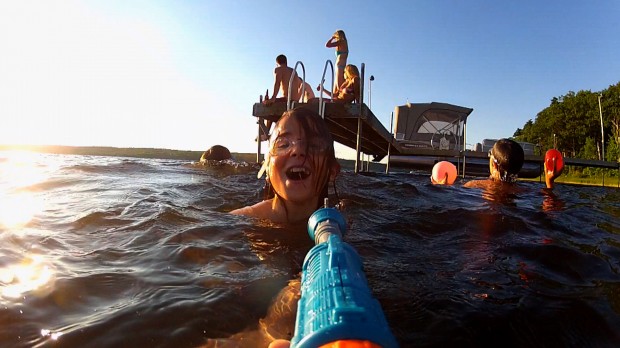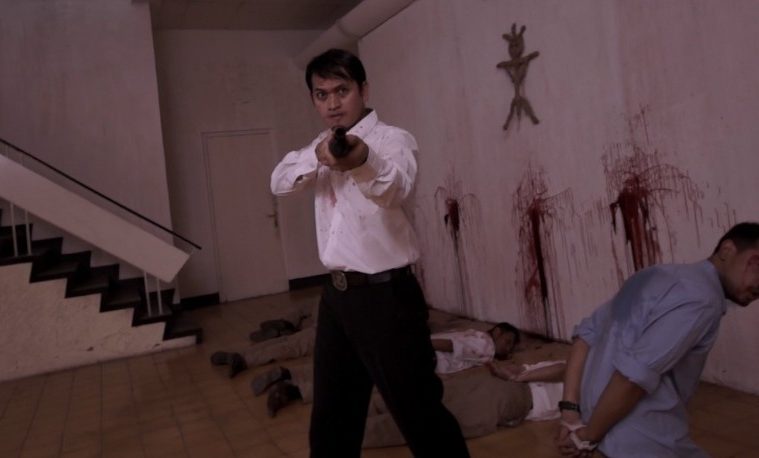
Horror anthologies are built on the strength of the individual shorts within. That means they can wildly fluctuate from segment to segment, which can leave you with a disjointed feeling about the experience as a whole. Where V/H/S seemed to generally fluctuate from good to mediocre, V/H/S/2 seems to veer even more sharply. Some segments are outstanding, while a few drag it down. That means I can wholly recommend the sequel, out in limited release now, based on the strength of a few segments alone. After the premiere of the film at SXSW, I was able to sit down a handful of the writers and directors to discuss lessons learned from the first, the crazy sound in Slumber Party Alien, naming the individual shorts, and which shorts they think would make a good feature. Enjoy the conversation below.
The Film Stage: Let’s start by saying your names and what you contributed to the film.
Gregg Hale: I co-directed The Ride in the Park short.
Eduardo Sanchez: I also co-directed The Ride in the Park and my dad rented out a goat. He was a goat pimp basically.
[All laughs]
Simon Barrett: I wrote and directed The Wrap Around and I also wrote the segment that Adam [Wingard] directed.
Jason Eisener: I directed the Slumber Party Alien production segment and I’m also looking forward to going to the goat pit.
Adam Wingard: I directed Phase One Clinical Trials.
I wanna start with yours, Jason, because the noise that you have every time the aliens show up is out of this world. I don’t know what the hell you did with that.
Eisener: It’s just a foghorn.
It’s just a foghorn?
Eisener: Yeah I think I found a clip of someone recording a foghorn on YouTube off a boat, like filming the actual buoy foghorn and then I took it and kind of warped it a little bit. So yeah it’s a foghorn. I guess I just found that noise kind of scary. It’s a huge sound. Also, too, I thought it kind of went with the aliens in our film are kind of, they come from the water and I tried to keep things within that water theme so the foghorn kind of stays within that. Potentially if someone saw the movie and then they were freaked out about aliens and then they were by the water and they heard a foghorn maybe they would draw a connection.
The film titles themselves, they play in the credits sequence but you have a lot of leeway, you can make that title very long, you can make it very short. Did you have a lot of fun coming up with the individual titles of your films?
Wingard: Well, for mine I feel every time anybody talks about the film they get my title wrong, because I think it’s been called “clinical trials” a lot of times, which is the problem with it actually not really being in the film. But it really doesn’t matter. I mean I don’t know if everybody pays attention to the title of the movies.
Sanchez: Yeah for us, the title honestly was a little bit of an afterthought. We didn’t really think about it having a title; we just wrote it.
In the first V/H/S, they had individual titles in the credits, right?
Barrett: Yeah, it was actually a lesson that we learned because the segment that I wrote that Joe Swanberg directed and Adam shot The Sick Thing that Happened to Emily When She Was Younger, everybody got that title wrong.
Wingard: It’s just Simon Barrett titles that no one can ever get right because they’re always so long.
Barrett: I do enjoying picking titles but in this one the titles are kind of generic. We just didn’t want to do anything too experimental because nobody got them right on the first film.

When you set out, do you give each filmmaker a certain time limit?
Wingard: We were all kind of in it together at the very beginning and I think everybody kind of just knew we needed deliver it before whatever that final date was. Whatever the final date that Jason turns his in is.
[Everyone laughs]
Eisener: I think it was like. I can’t quite remember but it was like to try the keep the script maybe under 20 pages.
Barrett: I think it was under 15. Because there wasn’t necessarily a forced thing but we all kind of agreed that shorter was better especially because I think the first V/H/S is, a lot of critical reviews have said the film is too long. A lot of people have said that it feels like one segment too long and the first V/H/S is about two hours long. V/H/S 2 is about 95 minutes so I think that was a goal.
Wingard: Yeah it was really the main goal going into this one it was like “well let’s make sure this one doesn’t clock in too much over 90 minutes.”
Barrett: We just want it to move really fast. So there was discussion of running time but nobody had any strict parameters but I think as filmmakers we all agree…
Sanchez: It was more about the minimum. It was more like you can’t deliver something like…
Two minutes.
Sanchez: Yeah. We needed to fill up a features worth of material.
Barrett: But then Gareth [Evans] and Timo [Tjahjanto] took care of that. [Laughs]
When you are making these, I assume you are filming these individually and not really connected to each other — you aren’t watching footage of each other.
Eisener: Well, we shared scripts; it may have been treatments first and then scripts — I can’t quite remember, but I remember getting everyone’s scripts and so we had an idea of what everyone else is doing so you wouldn’t do the same sort of thing, which was really good.
Wingard: And we all had our own teams that we work with and each one of us worked in different parts of the country basically, or the world, Indonesia, Halifax, but that’s kind of the cool thing about it: everybody has their own people and they do their own thing that’s why each one of the segments really also has that unique feel because they’re all kind of approached completely differently by everybody’s unique sensibilities.
Barrett: Well I will say that, Adam and I kind of learned a way of working together because we collaborate on a lot of films and I tend to write the scripts in isolation and he tends to edit in isolation and we did kind of learn that waiting to see a rough cut, so you can kind of experience it as a viewer, is sometimes a lot better than seeing people’s dailies and stuff and then kind of not really knowing what it is.
Wingard: What is anybody gonna say really? Watching it is just gonna get producers potentially more nervous and stuff.
Barrett: Especially because we used a lot of visual effects in this one. But Roxanne was on set for Greg and Eduardo’s segment and I was gonna fly out for Jason’s but a flight to Halifax was like half his budget. But we were kind of talking and stuff but yeah everyone had a free hand to not show us anything until they were feeling confident with it.
I know for you personally, Simon, you’ve been part of V/H/S, you’ve been part of ABC’s of Death and now you’re on V/H/S/2 as well . I know you were in ABC’s as well, Adam, and —
Barrett: Jason and Ed, as well.
OK. Is it becoming a lot easier? These are starting to become much more popular, the little horror anthologies, and is it becoming a lot easier to kind of figure out the inner workings of that?
Wingard: Yeah, I feel the reason that these things are all coming together anyways is because just to make a short film really doesn’t cost a lot of money because of the way the equipment and everything has advanced and become so consolidated that you can kind of go off and do these things. So it makes sense especially from a producing standpoint for them to hire filmmakers basically to do short films and you can get bigger name talent that way because you can just be like, “Hey, this doesn’t take much of your time and it’s a fun thing.”
“You can do it on your own, here’s the deadline.”
Wingard: Yeah from that perspective I feel like there’s just gonna keep being more of these because you can just go out to filmmakers and let them have fun with it.
Sanchez: I also think the audience, the attention span of the audience is getting so small now you’ve gotta constantly… you compare the cartoons that our kids watch to what we watched — it’s like fucking crazy. So I think that now shorts are becoming more popular because it is this little bit of, OK it’s cool, and then you go onto the next thing and there’s always something new happening which, in a film, is hard to sustain that. So it’s cool, you have these things with a new story, new characters, new effects, new approach and I think that’s what people love about it. It’s always a surprise.
Hale: I think shorts are particularly good for horror. Because I think you can throw all the horror beats in there you can set up the characters and then you just hit the horror stuff and then you’re done. So you kind of enjoy the best part of the horror film over and over again in these short little bursts. I think the thing in features a lot of times is you’re trying to sustain a story and you can’t have horror beat after horror beat but you look at all these, and your stuff starts, you’re in the horror stuff pretty damn quickly and then it just sustains the whole time.
Wingard: Yeah and you can also just do stuff that you wouldn’t see necessarily in a full length feature version of it because a lot of our ideas I think in V/H/S/2 are kind of things that wouldn’t really sustain an entire movie but being in little sections it’s like perfect, it’s the perfect way to do these things.
Sanchez: And you can show a cock right away.
[Everyone laughs]

It’s difficult to watch shorts and festivals, write about them and say, “this is awesome, but you can never find this.”
Wingard: That’s a good point, because that’s the number one thing I like about doing these anthologies. I do short films anyway and always have, but I kind of stopped for a little while because it did kind of seem futile a little bit. But this is a way to actually do a short film and it guarantees an audience for it.
One last question: do you have any kind of agreements? Perhaps not written down or anything contractual, but is everything that appears in V/H/S and V/H/S/ 2 — nobody is going to spin this off into a feature film? Any of these directors or writers or things like that? Or would you encourage that?
Barrett: I mean, that’s something that was talked about with the first V/H/S and actually Joe Swanberg and I even at one point put together a giant treatment for The Sick Thing that Happened to Emily segment and ultimately I think we looked at it and were like “this doesn’t work as a feature. This was written and conceived as a short for a good reason.” Watching 90 minutes of people have a Skype conversation is not gonna hold up. It only works in like 15 minutes. I think that could happen. I think people are open to it but I personally just think that the shorts work as shorts. Especially the ones in V/H/S/2. Maybe Radio Silence’s [10/31/98] from the first V/H/S, but I think they’re busy. And I think in terms of contractual stuff I think the rights are owned by Bloody Disgusting and The Collective so if everyone was inspired, it could happen but I think we and they would be better off just making more shorts.
Wingard: I think contractually, if we were to make features out of our shorts, it’s with The Collective-
Barrett: Yeah, they own the intellectual property to all the ideas. So yes, in terms of the contractual stuff that’s your answer but in terms of the creative stuff it would be hard to sustain that.
Wingard: I could see Jason’s as a feature.
Barrett: Jason’s is probably the one. A lot of people said Gareth and Timo’s but I personally like Gareth and Timo’s the way it is.

V/H/S/2 hit limited theaters this past weekend and is now on VOD.

